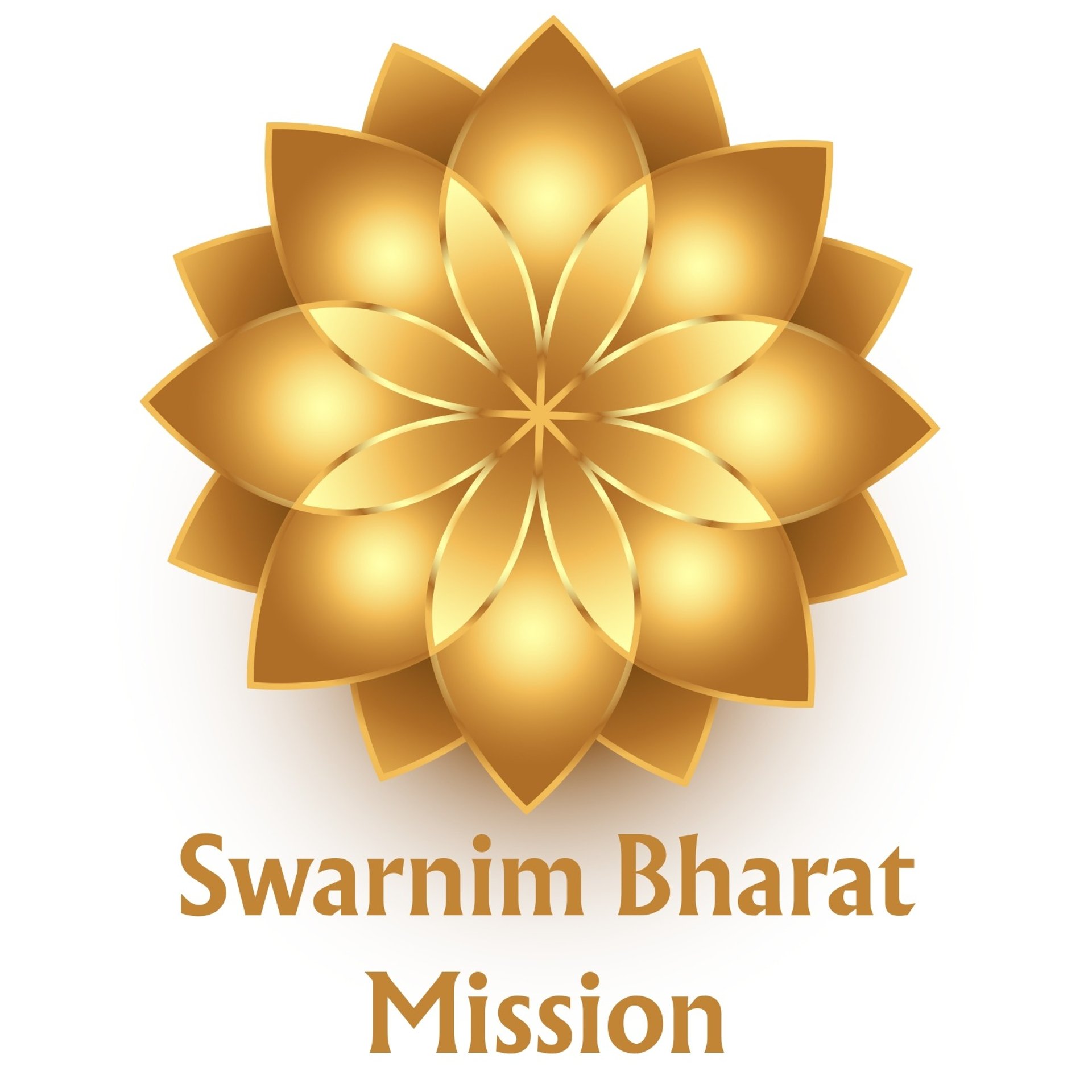
FAQ's
Frequently Asked Questions: Your questions, our answers
1. Mission Overview
What is the Swarnim Bharat Mission?
Swarnim Bharat Mission is a mission-aligned social enterprise dedicated to accelerating the realization of Viksit Bharat 2047, while contributing directly to the UN Sustainable Development Goals. Privately managed and operationally independent, Swarnim aligns its initiatives with India’s national priorities to drive inclusive social and economic development—particularly in marginalised rural and tribal regions. By integrating renewable energy, regenerative agriculture, skills & enterprise development, and values-based leadership, we enable villages to become resilient engines of sustainable growth.
What inspired the launch of the Swarnim Bharat Mission?
The Mission is inspired by India’s rich cultural heritage, its underutilized human capital, and the deep reservoirs of knowledge within Vedic and tribal traditions. Recognizing the opportunity to bridge traditional strengths with modern innovation, Swarnim Bharat acts as a convergence platform that transforms cultural assets, indigenous wisdom, and local capabilities into drivers of inclusive and sustainable development.
What makes your approach different from other rural development initiatives?
Our distinctiveness lies in our holistic and values-driven framework. While many initiatives focus primarily on economic or social outcomes, our approach integrates spiritual well-being, skills development, enterprise creation, scientific innovations and access to global markets. We go beyond providing external inputs—our model emphasizes building endogenous community capacity, enabling people to become drivers of their own transformation. This creates a scalable and replicable pathway for inclusive development that is both future-oriented and deeply anchored in India’s cultural and knowledge traditions.
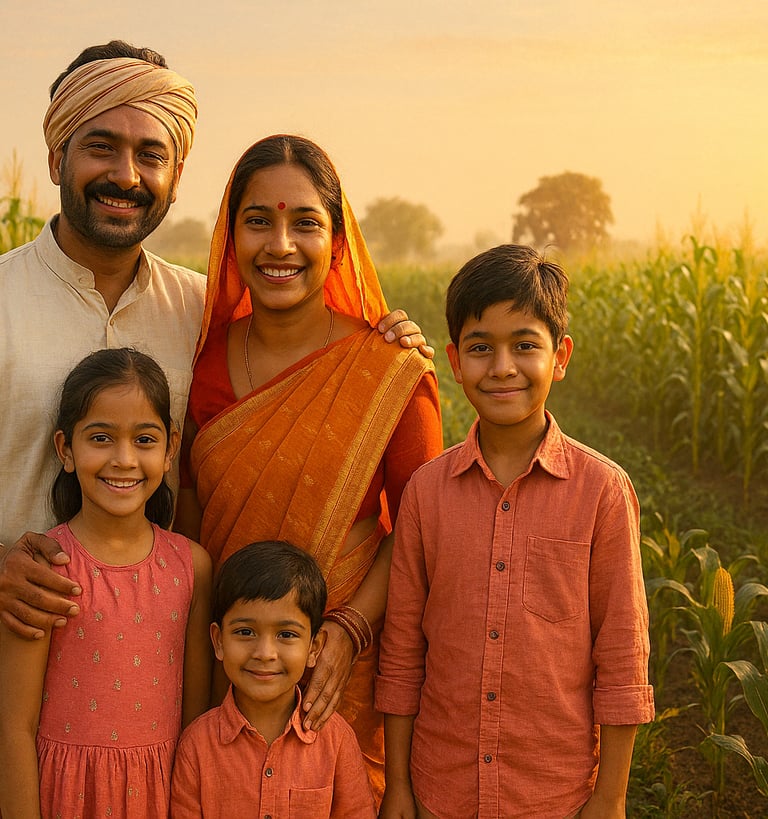

What is the mission plan?
Our plan is to Map 100 high-potential BPL, remote and tribal districts using key indicators such as per capita income, soil health, and groundwater levels. Our Mission Sahiyogis, Brahma Kumaris, help foster inner resilience through Raj Yoga and build skills in Sustainable Yogic Agriculture. This synergy will be enhanced with support from NGOs, to help drive SHG-led, Neutrino-powered micro-enterprises to boost farm output, reduce wastage through cold storage and processing, and connect produce to local and global markets through multi-channel distribution.
Who is responsible for implementing the mission?
The Mission will be delivered by a consortium of accredited development institutions, NGOs, community organizations, innovation hubs, and private impact investors. A central coordinating body will ensure transparent governance, continuous monitoring, and measurable impact, combining local expertise with global best practices to maximize efficiency and accountability.
How do you measure the impact?
We measure impact using a structured Monitoring & Evaluation (M&E) framework that combines quantitative indicators, qualitative assessments, and third-party validation. The framework is built around baseline → monitoring → outcome → impact stages and emphasizes data quality, reproducibility and independent verification. The M&E approach ensures our claims are measurable, verifiable and policy-relevant, enabling continuous learning, course correction and credible reporting to stakeholders.
How do you ensure that innovations move effectively to scalable solutions?
Gramayana, a central knowledge and IP repository and innovation hub will connect decentralized innovation clusters, research labs, universities, and tribal talent to develop, prototype and scale solutions tailored for rural India and global needs.


2. Implementation
3. Education & Skills Development
How does the mission incorporate education for women and youth in tribal regions?
The Swarnim Bharat Mission sahiyogis, Brahma Kumaris would help establish skill hubs focusing on empowering women and youth. These hubs would offer training in Sustainable Yogic Agriculture and other livelihood-enhancing practices, blending traditional wisdom with practical vocational skills contextually relevant to tribal and rural settings.
What is 'Sustainable Yogic Agriculture' and how is it taught?
Sustainable Yogic Agriculture combines natural farming practices with yogic meditation. It is taught through a combination of workshops, field demonstrations, and spiritual mentoring by certified trainers from Brahma Kumaris. This approach enhances soil vitality and farmer wellbeing, creating a holistic agricultural ecosystem.
Is there a focus on technology in skill development?
Certainly. The mission includes training in digital literacy, solar and irrigation systems, drone use in agriculture, and exposure to emerging areas like fintech and neutrino energy. These skills are made accessible and relevant through practical, localized application.
Which gaps in India’s national vision does Swarnim address?
While national economic growth is predominantly urban-centric, achieving sustainable and inclusive development requires empowering rural and marginalized communities. The Mission aims to bridge socio-economic disparities between cities and last-mile villages, rural BPL (below the poverty line) and tribal populations. Through targeted interventions addressing energy insecurity, post-harvest losses, weak market linkages, and limited entrepreneurship, the Mission enables rural communities to participate equitably in long-term national development, contributing to a prosperous and inclusive future by 2047.
How will Swarnim achieve its goals?
By deploying an integrated model combining four pillars:
Spiritual Leadership & Inner Development — capacity building led by Brahma Kumaris to instill self-belief, discipline and purpose among rural youth and women.
Skills & Agritech — training in entrepreneurial skills, yogic/regenerative agriculture, and science-led, civilization anchored rural development.
Enterprise Creation — support to Self-Help Groups (SHGs), cooperatives and micro-enterprises aligned with UN SDGs and India’s cultural strengths.
Strategic Partnerships — collaborations with global technology partners, financiers and local governments to scale decentralized power, cold chain, and market infrastructure to bring world-class solutions to the grassroots level.
Why is the spiritual component included in a development mission?
We believe sustainable development must address both material and human potential. The spiritual component is not religious; it is about building core human values—integrity, resilience, and compassion. By strengthening inner capital, we create individuals who are not only skilled but also ethically grounded, community-oriented, and driven to become lifelong agents of positive change. This ensures development is deep-rooted and self-perpetuating.
Tell us about your strategic allies and the roles do they play?
Brahma Kumaris offer program leadership our structure (human development), technology alliance with Germany's Neutrino Group (for renewable and decentralised energy solutions), local NGOs (such as Sukhi Parivar, for tribal community mobilisation), several academic institutions (for research and evaluation), and private sector and donor partners (to finance and scale). Our strategic allies contribute expertise, capacity, or resources in clearly defined roles to ensure measurable impact.
How do you define "Antyodaya" in your mission?
As lifting the last person first. Our spatial GDP mapping identifies India’s most underserved districts, ensuring tribals and BPL communities benefit and the socio economic gap divide is bridged to meet national policy targets. Our primary focus is on India's most underserved regions, which often have the greatest potential for growth. This includes remote villages, tribal belts, and districts with high concentrations of communities living below the poverty line (BPL). We prioritize areas where our integrated model can have the most transformative impact.


Why does India need the Swarnim Bharat Adiyogi Gurukul?
With 85% of tribal youth dropping out by Class 10 (NITI Aayog 2023) and mainstream schooling erasing cultural identity, our Gurukul offers the antidote—teaching in tribal languages before transitioning to English and Hindi, co-designing curricula with village elders, and guaranteeing 100% job placement in tribal tech hubs or village startups. This is not “alternative” education—it’s the missing bridge between heritage and the future.
How can Gurukuls solve India’s skill crisis?
By mining the world’s oldest knowledge economy—tribal India. While 53% of graduates are unemployable (ASER 2022), Bharat's Vedic and tribal led Gurukuls can tackle India’s skill crisis by tapping into the world’s oldest knowledge economy—tribal India—where youth gain hyper-local skills like organic farming and drone irrigation, global tech skills like AI-powered oral history documentation, and leadership experience through ‘Gram Pradhan Fellowships’ for young changemakers.
What makes Swarnim Bharat Adiyogi Gurukul different??
Our Swarnim Bharat Adiyogi Gurukul (100% free residential school & university for tribal students in planning) are unlike conventional schools—we don’t just teach, we awaken potential. By fusing ancient wisdom with 21st-century skills, students master Vedic ecology alongside AI-powered farming, oral storytelling with digital content creation, and traditional medicine with biotech labs. Every graduate earns a STEM degree plus certification in ancestral knowledge, becomes fluent in both their native language and global tech tools, and commits to a five-year Return to Roots pledge to uplift their communities. This isn’t education—it’s the blueprint for a civilizational revival.
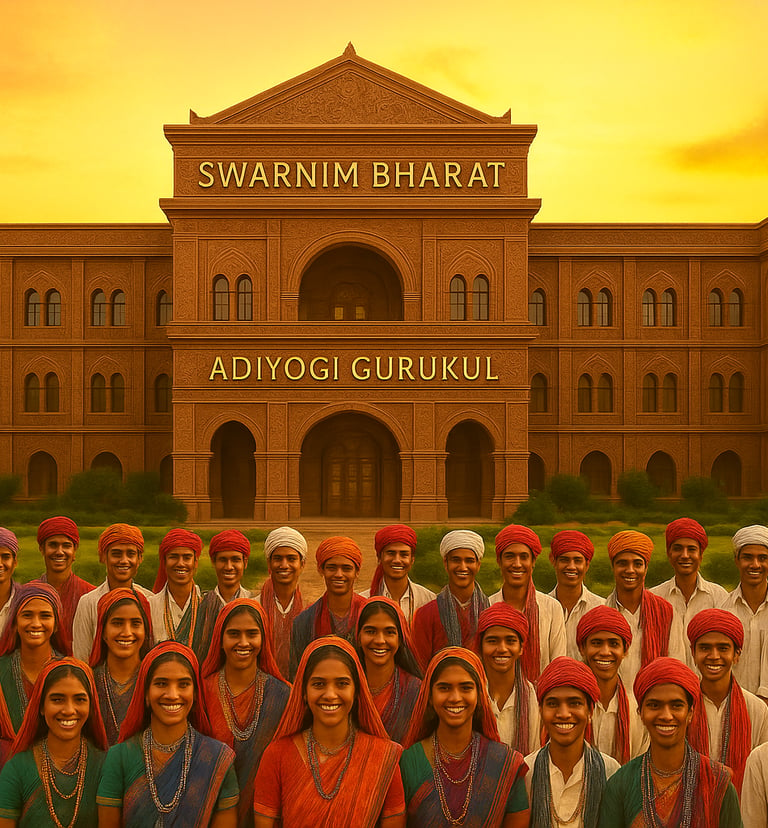

4. Sustainability
How many SDGs does the Swarnim Bharat Mission address?
The Swarnim Bharat Mission actively advances 14 SDGs—namely 1, 2, 3, 4, 5, 6, 7, 8, 9, 10, 12, 13, 16 and 17.
How could you possibly manage to advance so many goals simultaneously?
This is possible because our mission is village-centric, rooted in India’s civilizational heritage, and driven by holistic development. By empowering rural communities through integrated economic, social, and environmental strategies, we create a multiplier effect—where progress in one area naturally fuels progress in many others.
What makes your approach to sustainably unique?
We don’t “chase” SDGs — we grow them. Ours is not a checklist, but a living ecosystem rooted in Bharat’s civilizational wisdom. For millennia, we have lived by the Vedic truth: the Earth is not a commodity, but kin. When you treat soil, water, and biodiversity as sacred, you build unshakable foundations of resilience, culture, and community. From these roots, a mighty trunk rises — and the SDGs emerge naturally. Our role is to tend this living tree, fusing ancient genius with cutting-edge innovation, so the harvest feeds not just the present, but the unborn future.
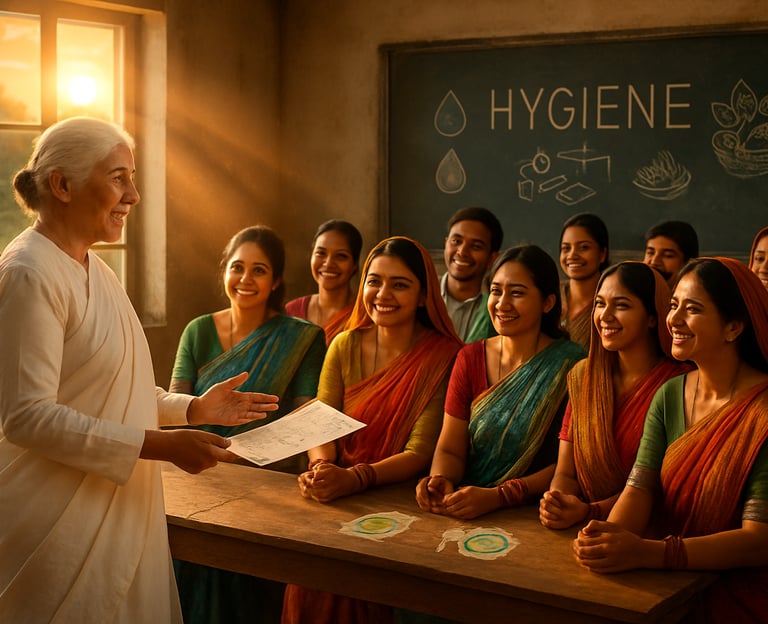



5. Economics
Why is Swarnim Bharat 'home coming' such a strategic imperative?
Demographic Dividend Realization
65% rural population → $1.9T consumption opportunity (World Economic Forum)
But requires: Energy access + digital inclusion (current gap: 68%)
Climate Resilience Advantage
Tribal forest stewardship → 30% cheaper carbon capture vs. tech solutions (TERI)
Cultural GDP Unlock
Food processing/ayush markets: $200B by 2030 (FICCI) – currently fragmented
Swarnim Bharat isn't nostalgia—it's ROI. Every 1% shift toward civilizational-aligned development yields 2.3x rural ROI versus urban infrastructure spend.
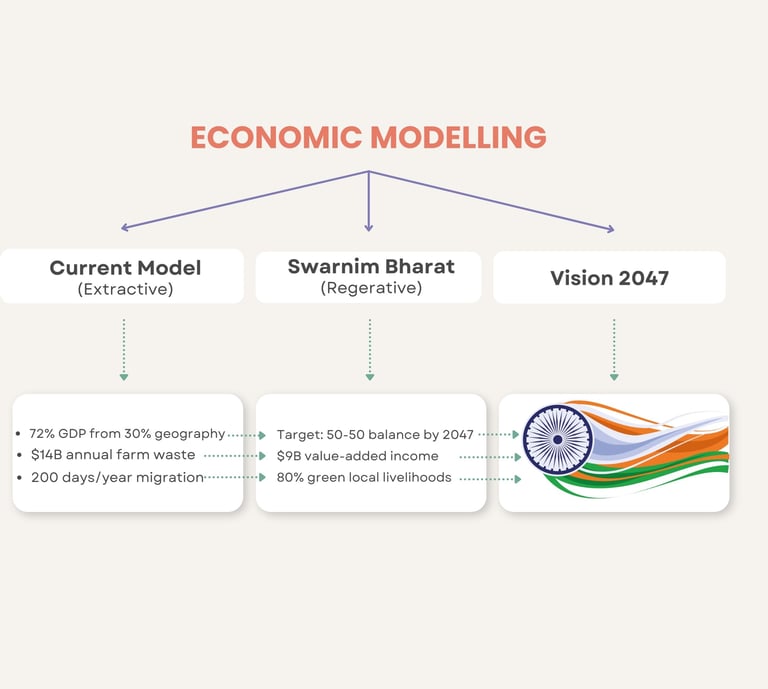

Why does directing CSR funds to Swarnim Bharat deliver greater impact?
Investing CSR funds in Swarnim Bharat is not charity—it is strategic nation-building with measurable economic multipliers:
1. Enduring Socio-Economic Assets: Swarnim Bharat converts "golden history" into investible IP pipelines, permanent infrastructure, skilled human capital, and sustainable livelihoods—locking in long-term value far beyond one-off projects.
2. Sustainable Supply Chain Development: Builds skilled, reliable local workforces and sustainable resource bases that corporates can tap into directly. By transforming rural communities into self-reliant consumer bases and skilled resource hubs, unlocks new demand while building ethical, resilient supply chains.
3. Cost Efficiency Through Social Stability: Reduces future welfare costs by curbing poverty-driven migration, instability, and dependency—freeing public/corporate capital for growth.
4. Legacy Brand Equity & ESG Leadership: Positions CSR investors as nation-building pioneers, accelerating ESG ratings and global trust via measurable, generational impact aligned with Viksit Bharat 2047.
Genuine Empowerment
The bronze that called the gods to dine,
Now marks the hour for Bharat to shine!
Where women grind not grain but gold;
In villages where dreams take daring hold!
© 2025 Swarnim Bharat Mission. All rights reserved
Amplifying development Focussed on Bharat's last mile villages
info@swarnim.co
Swarnim Bharat Mission
